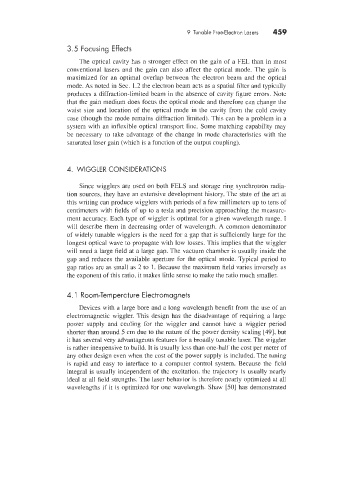Page 499 - Tunable Lasers Handbook
P. 499
9 Tunable Free-Electron Lasers 459
3.5 Focusing Effects
The optical cavity has a stronger effect on the gain of a FEL than in most
conventional lasers and the gain can also affect the optical mode. The gain is
maximized for an optimal overlap between the electron beam and the optical
mode. As noted in Sec. 1.2 the electron beam acts as a spatial filter and typically
produces a diffraction-limited beam in the absence of cavity figure errors. Note
that the gain medium does focus the optical mode and therefore can change the
waist size and location of the optical mode in the cavity from the cold cavity
case (though the mode remains diffraction limited). This can be a problem in a
system with an inflexible optical transport line. Some matching capability may
be necessary to take advantage of the change in mode characteristics with the
saturated laser gain (which is a function of the output coupling).
4. WIGGLER CONSIDERATIONS
Since wigglers arc used on both FELS and storage ring synchrotron radia-
tion sources, they have an extensive development history. The state of the art at
this writing can produce wigglers with periods of a few millimeters up to tens of
centimeters with fields of up to a tesla and precision approaching the measure-
ment accuracy. Each type of wiggler is optimal for a given wavelength range. I
will describe them in decreasing order of wavelength. A common denominator
of widely tiinable wigglers is the need for a gap that is sufficiently large for the
longest optical wave to propagate with low losses. This implies that the wiggler
will need a large field at a large gap. The vacuum chamber is usually inside the
gap and reduces the available aperture for the optical mode. Typical period to
gap ratios are as small as 2 to 1. Because the maximum field varies inversely as
the exponent of this ratio, it makes little sense to make the ratio much smaller.
4.1 Room-Temperature Electromagnets
Devices with a large bore and a long wavelength benefit from the use of an
electromagnetic wiggler. This design has the disadvantage of requiring a large
power supply and ccohg for the wiggler and cannot have a wiggler period
shorter than around 5 cm due to the nature of the power density scaling [19], but
it has several very advantageous features for a broadly tunable laser. The wiggler
is rather inexpensive to build. It is usually less than one-half the cost per meter of
any other design even when the cost of the power supply is included. The tuning
is rapid and easy to interface to a computer control system. Because the field
integral is usually independent of the excitation. the trajectory is usually nearly
ideal at all field strengths. The laser behavior is therefore nearly optimized at all
wavelengths if it is optimized for one wavelength. Shaw [50] has demonstrated

